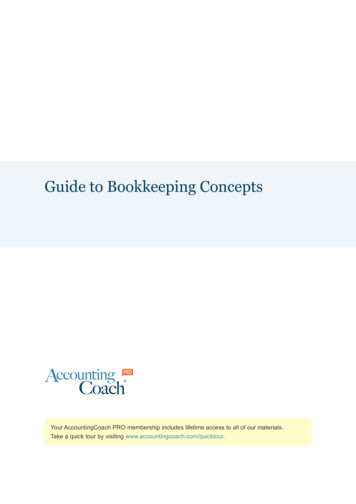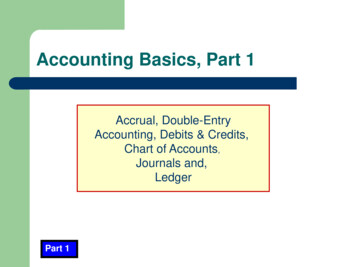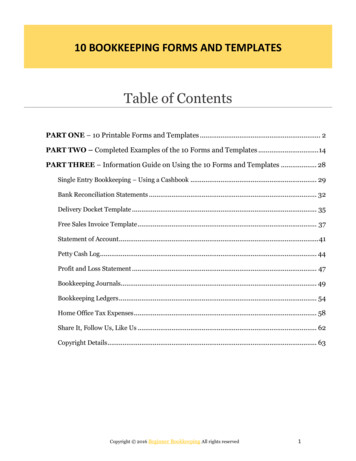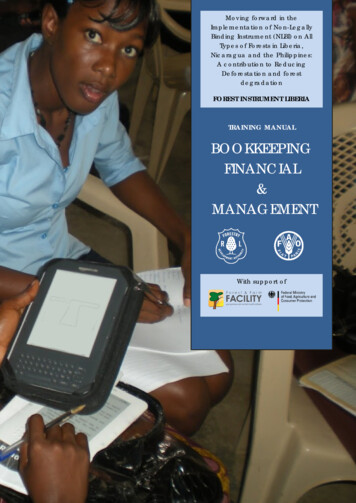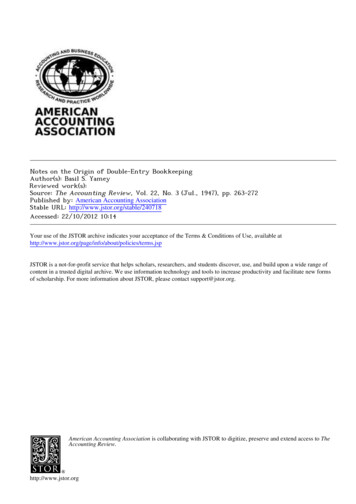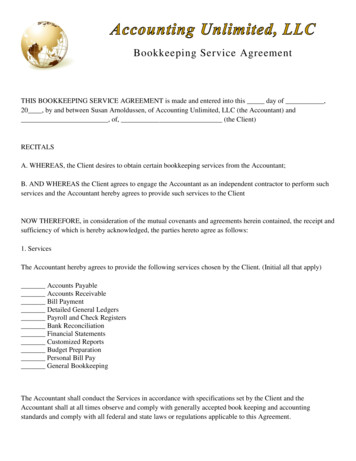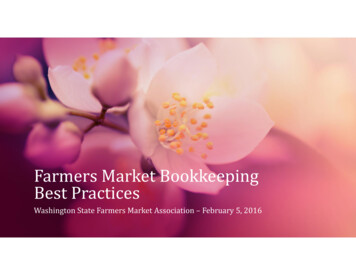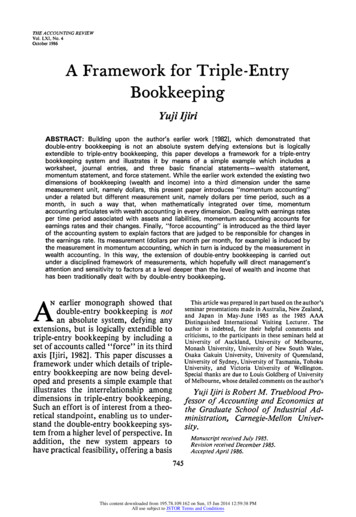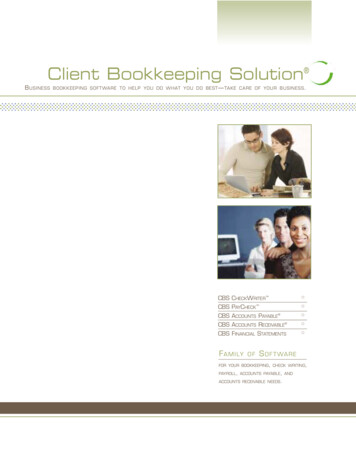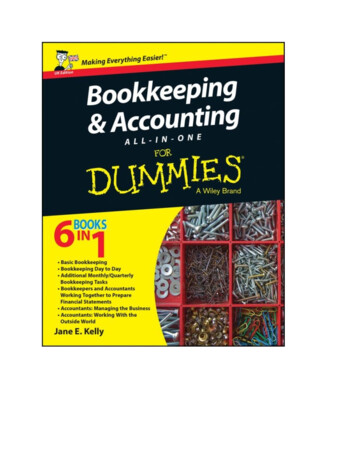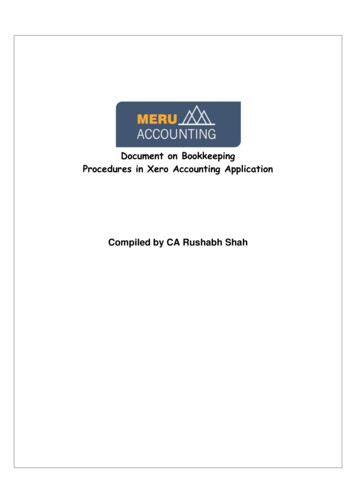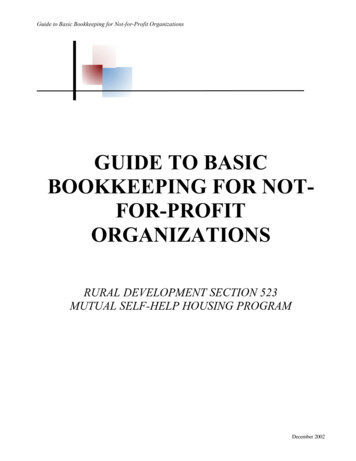
Transcription
Guide to Basic Bookkeeping for Not-for-Profit OrganizationsGUIDE TO BASICBOOKKEEPING FOR NOTFOR-PROFITORGANIZATIONSRURAL DEVELOPMENT SECTION 523MUTUAL SELF-HELP HOUSING PROGRAMDecember 2002
Guide to Basic Bookkeeping for Not-for-Profit OrganizationsA Guide for Grantees of the USDA Section 523 Self-Help Housing ProgramDeveloped jointly by the Self-Help Housing Technical and Management Assistance (T&MA)Contractors:Florida Non-Profit Housing, Inc. (FNPH)Little Dixie Community Action Agency, Inc. (LDCAA)National Council of Agricultural Life and Labor Research Fund, Inc. (NCALL)Rural Community Assistance Corporation (RCAC)Funded by: United States Department of Agriculture, Rural DevelopmentThe work that provided the basis for this publication was supported by funding under an award withthe U.S.D.A. Rural Development. The substance and findings of the work are dedicated to the public.The T & MA Contractors are solely responsible for the accuracy of the statements and interpretationscontained in this publication. Such interpretations do not necessarily reflect the views of theGovernment.Published in 2002 by the T & MA Contractors, this guide is designed to provide accurate andauthoritative information in regard to the subject matter covered. It is distributed with theunderstanding that the authors are not engaged in rendering legal, accounting, or other professionalservices. If legal or other expert assistance is required, the services of a competent professional personshould be sought.All rights reserved. The text of this publication, or any part thereof, may not be reproduced in anymanner whatsoever without written permission from the T & MA Contractor. If you wish to make ordistribute copies, please write a letter indicating the number of copies that you wish to make ordistribute, the size and type of audience to whom you wish to distribute, and the type of organizationor agency that you are. Send the letter to:Region IFlorida Non-Profit Housing, IncP.O. Box 1987Sebring, FL 33871-1987(863) 385-2519fnph@earthlink.netRegion IILittle Dixie Community Action Agency, Inc.502 W. DukeHugo, Oklahoma 74743(580) 326-5165bharless@ldcaa.orgRegion IIINCALL Research, Inc.363 Saulsbury Rd.Dover, Delaware 19904(302) 678-9400info.ncall.orgRegion IVRural Community Assistance Corporation3120 Freeboard Drive, Suite 201West Sacramento, CA 95619(916) 447-2854www.rcac.orgRefer to the Introduction Chapter of this guide to identify the appropriate T & MA Contractor to contact for your area.After receipt of a consent and conditions letter you may copy and distribute the manual in accordance with such terms andconditions as set and approved by the T & MA Contractors.December 2002
Guide to Basic Bookkeeping for Not-for-Profit OrganizationsTable of ContentsChapterPageIntroduction to the Mutual Self-Help Program . . 1Additional Training Materials . 7Introduction to this Guide . . 11Basic Bookkeeping Principles . 12Assets, Liabilities, and Net AssetsThe Bookkeeping EquationBusiness Transactions and Changes in the Bookkeeping EquationThe LedgerManual Bookkeeping System . 17JournalsTrial BalanceSix Column WorksheetFinancial StatementsMonthly Financial MonitoringCash vs. AccrualClosing the LedgerCash Systems and Checking AccountsThe Bank StatementThe Petty Cash FundPayrollAutomated Accounting System . 32Addendum . 38SFA 117SFA 116Summary . 40List of Appendices. 41December 2002
Guide to Basic Bookkeeping for Not-for-Profit OrganizationsINTRODUCTIONThe Self-Help ProgramSelf-Help Housing is just as it sounds: Participants working together to build their own homes.This cooperative effort is a direct application of the church and barn raising techniques of the Amishand Mennonites. The participants supply the necessary labor while qualifying for mortgage financingto purchase land, materials, and subcontract work on very technical items. A private nonprofitcorporation, public body, or rural town can obtain a grant from Rural Development to hire skilledstaff, rent office facilities, pay for mileage, and purchase tools. This staff then works with theparticipants by providing the assistance and training necessary to fulfill the goals of the self-helphousing program. The specifics of the program are described below.With the assistance of the skilled staff, an association of generally 4 to 10 households isformed. (Once the grant is completed, at least 40% of the total participants served must have beenvery low income, 50% or less of the county median income.) They select lots, house plans, and applyfor individual mortgage loans.While participants await loan approval, the group studies theresponsibilities of homeownership, construction techniques, tool usage, safety, homeowner’sinsurance, taxes, home maintenance, and money management.This time is known as the pre-construction stage.Once the loans are approved, the group begins to build under the guidance of a skilledconstruction supervisor. The participants must complete a minimum of 65% of the construction labortasks, until the group of homes is completed; usually the more technical work is subcontracted out.The construction stage lasts from 6 to 12 months, depending on the size of the group. Participantswork during their spare time (evenings, weekends, and days off) so as not to interfere with the regularhousehold employment. Rural Development loans feature interest rates ranging from 1% to themarket rate, depending on the household’s adjusted annual income. The repayment period is 33 or 38years and no down payment is required.1December 2002
Guide to Basic Bookkeeping for Not-for-Profit OrganizationsRural DevelopmentRural Development is an agency of the United States Department of Agriculture. It wasoriginally a credit agency for lower income farmers who could not qualify for loans elsewhere. Sincethe 1960's rural non-farm households have been eligible for mortgage credit. Rural Development’sfunction as a lender is significant because private credit institutions in rural areas are relatively few innumber, smaller, and often impose more rigid terms, which can be a barrier to homeownership.The Rural Development mission is to help rural Americans improve the quality of their lives.Rural Development helps rural communities meet their basic needs by: Building water and wastewater systems, Financing decent, affordable housing, Supporting electric power and rural businesses, including cooperatives, and Supporting community development with information and technical assistance.Rural Development has been providing the funds for the self-help housing program since thelate 1960's. They provide technical assistance grants to eligible entities to start and implement theprogram and they thoroughly review the preapplication and final application before a grant is awarded.When a grant is awarded, Rural Development is saying that there is a need for self-help housing in thisarea; this agency is suited to administer a self-help housing program; the proposed plan, budget andschedule are feasible; house plans meet local, state and Rural Development building codes; adequatebuilding sites are available; the project ingredients are in place; and Rural Development is ready toprovide the financial resources necessary to make the project work. There is no charge to participatinggroups. Grant funds provided to grantees by Rural Development do not have to be repaid. It is aninvestment Rural Development is willing to make in order to see self-help housing work.Rural Development will continue to monitor and provide oversight in the areas of constructionand administration, through quarterly meetings, construction inspections, and participant accountsthroughout the term of the program.In many cases Rural Development provides another important ingredient to the self-helpprogram, construction/permanent financing. They are independent of private or conventional lendinginstitutions; the financing is directly between Rural Development and the borrower. While labor andconstruction are group efforts, each applicant must qualify and obtain a loan directly from RuralDevelopment.2December 2002
Guide to Basic Bookkeeping for Not-for-Profit OrganizationsRural Development OfficesRural Development usually operates from four levels: national, state, area and local.The National Rural Housing Service Administrator in the National Office and the StateDirectors are politically appointed – all others are federal civil service employees.Rural Housing Service National OfficeThe Rural Housing Service National Office is responsible for developing policy andinteracts with Congress for legislation development and program funding.National Office also awards and monitors all Section 523 grants.TheThe program staffat the national level maintains reports and statistics on operating self-help organizationsand projected needs for funding.Rural Development State OfficeThe State Office has the approval authority over the smaller Section 523 grantapplications. Section 502 loans are allocated on a state-by-state basis and the StateOffice allocates the 502 money based on a State formula. There are additional staffmembers who are key to the operation of a self-help program located in many StateOffices:Rural Development State DirectorRural Housing Program DirectorRural Development State ArchitectRural Development AppraiserRural Development Housing SpecialistRural Development Area OfficeThe Rural Development Manager is responsible for the Section 523 grant. It ishis or her responsibility to ensure that the grant is operated effectively and inaccordance to regulations. The Rural Development Manager will evaluate the Section523 self-help agencies on a quarterly basis and review grant applications for new andon-going programs. In addition, Rural Development Construction Analysts are usuallyavailable through this office.3December 2002
Guide to Basic Bookkeeping for Not-for-Profit OrganizationsRural Development Local OfficeWithin this office, the Community Development Manager is responsible formaking the Section 502 mortgages to participating applicants of each group. He or shewill be responsible for monitoring the 502 loans and will also be the co-signer on theparticipant checking accounts. Usually, this office does construction inspections.The Rural Development Section 502 Rural Housing LoanMany applicants that participate in the self-help housing program use Rural DevelopmentSection 502 loan to finance their homes. Section 502 loans are only available to families living inrural areas. "Rural" is defined as towns with populations of 10,000 or fewer, and designated citieswith populations between 10,000 and 20,000 in counties that are not associated with StandardMetropolitan Statistical Areas (SMSA) where a serious lack of mortgage credit exists.In order to qualify for a Section 502 loan, prospective self-help applicants must meet RuralDevelopment income eligibility requirements as low-income or very low-income. They must becredit-worthy, have repayment ability for the loan requested, and be unable to secure credit from othersources. The low-income measure is 80% or less of the county median income, based on family size.Very low-income is defined as 50% or less of the county median income, based on family size. Theseincome standards, established by HUD and adopted by Rural Development, are subject to localvariation and periodic change. Current information on income standards and eligibility requirementsfor Section 502 loans is available at Rural Development local offices.The repayment period for the Section 502 loan is either 33 or 38 years, and the interest rate isbetween 1% and the current market rate. The actual rate of interest the borrower pays depends on theborrower's income, as does the loan term. If a borrower is eligible to pay less interest than the marketrate, the borrower then receives a subsidy called “payment assistance”. The amount of paymentassistance a borrower receives is determined by the loan amount, loan period, and the householdincome. The assistance makes up the difference between the full loan rate and the rate the participantpays.Section 502 funds are advanced from the Rural Development finance office in St. Louis anddisbursed by the local offices based on regulatory guidelines. TA grantees prepare the drawdowns andchecks for each participant's account as needed to purchase materials for different phases ofconstruction. Note that the participant's loan payments are deferred during construction.4December 2002
Guide to Basic Bookkeeping for Not-for-Profit OrganizationsWhen all the money is withdrawn from a participant's account, Rural Development's financeoffice sends payment books to the participant. The participant's first loan payment is due within thirtydays of termination of deferred payments.Payments then go directly to Rural Development’sCentralized Servicing Center (CSC) in St. Louis.The 523 Mutual Self-Help Housing Technical Assistance GrantIn order to enable organizations to operate a mutual self-help housing program, RuralDevelopment provides grant funds to operate and oversee mutual self-help housing programs. EachTA grant is usually for a period of up to two years, and is available to public and private nonprofitorganizations and units of state or local government. The amount of grant funds an organization canreceive is based upon how many houses they build in a grant period. An organization can receive 15%of the average cost of a new home financed under the 502 program in their area, for every home theyare planning to build.Activities that are allowable uses of Section 523 Technical Assistance grant funds include: Recruiting eligible households to participate in the self-help program; Holding training meetings with participants on the self-help process andhomeownership topics such as mortgages, in
Guide to Basic Bookkeeping for Not-for-Profit Organizations 1 December 2002 INTRODUCTION The Self-Help Program Self-Help Housing is just as it sounds: Participants working together to buil d their own homes. This cooperative effort is a direct application of the church and barn raising techniques of the Amish and Mennonites. The participants supply the necessary labor while qualifying for mortgage
